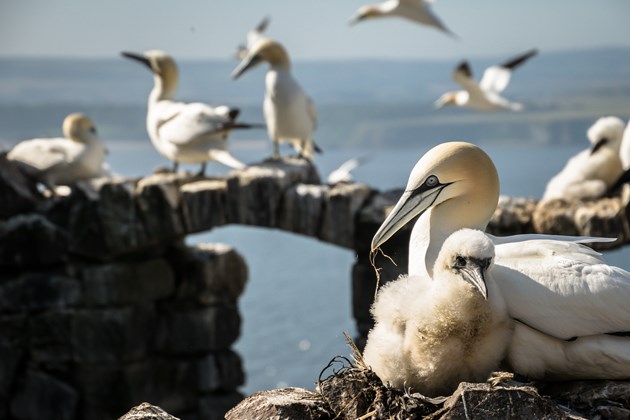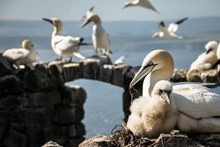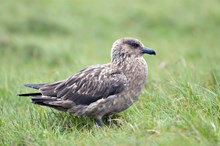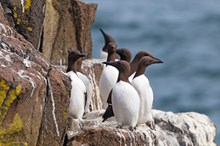21 July, 2022
Avian flu update: NatureScot advises public landings to stop on 23 islands

NatureScot is advising public landings to stop on 23 Scottish islands, limiting the spread of avian flu and giving seabirds the best possible chance to survive and recover from the current severe outbreak.
As of this week, the following islands have been advised to stop public landings until chicks have fledged.
Until the end of August for breeding puffins, Arctic skuas and Arctic terns:
- Orkney - Calf of Eday, Swona & Muckle Skerry
- Firth of Forth – Craigleith, Inchmickery, Isle of May
Until mid-September for breeding great skuas, common terns, cormorants and fulmars:
- Shetland - Noss
- Argyll - Glas Eileanan (Sound of Mull)
- Firth of Forth – Lamb and Fidra
Until mid-October for breeding gannets, storm-petrels and Manx shearwaters:
- Shetland - Ramna Stacks & Gruney
- Western Isles - Flannan Isles, North Rona & Sula Sgeir, St Kilda (Dun, Soay, Boreray, Stac an Armin and Stac Li - excluding the main island of Hirta)
- Highland - Priest Island
- Argyll - Treshnish Isles
- Firth of Forth – Bass Rock
Visitors will still be able to enjoy the summer seabird spectacle by taking boat trips to seabird colonies without coming ashore, or by viewing seabirds from a safe distance without entering nesting areas. The situation will be under constant review and restrictions will be lifted as soon as possible, once the birds have finished breeding.
To make this decision, NatureScot carried out rapid assessments of all island Special Protection Areas (SPAs) designated for breeding seabirds, in consultation with island managers. Relevant commercial boat operators have also been alerted, as well as all other recreation and visitor bodies and the local access authorities. The measure is the latest in response to growing concern over the spread and impact of the current H5N1 strain of avian flu, particularly in seabird colonies.
Eileen Stuart, NatureScot’s Deputy Director of Nature & Climate Change, said: “Restricting visits to these islands is not an easy decision, but we are increasingly concerned about the devastating impact avian flu is having in Scotland, particularly on our seabird colonies.
“Many of our Scottish islands are a haven for internationally important bird populations. With the avian flu crisis evolving so quickly, we have to respond to reduce the spread of this virulent disease. Tragically, this destructive disease could be with us for some time to come. In Scotland, with the new Task Force announced last week, we and our partners are committed to sharing our expertise and co-ordinating action on the ground.”
The virus is widespread across Scotland, with positive cases recorded in Shetland, Orkney, Outer and Inner Hebrides, Highland, Moray, Aberdeenshire, Angus, Fife, East Lothian and Scottish Borders. Seabird colonies at Noss, Hermaness, Hoy, St Kilda, Troup Head, Handa, Bass Rock and St Abbs have all been badly affected.
Great skua, gannet and guillemot have been hardest hit. Sample surveys of colonies show up to a 85% at decline of great skua at colonies in Orkney and up to 25% decline in gannet numbers at Shetland colonies. Great black-backed gull, herring gull, kittiwake, Arctic tern, Sandwich tern, razorbill and puffin have also tested positive.
NatureScot have also released guidance for both site managers and visitors on minimising risks for wild birds, biosecurity, and monitoring this week. The advice is available on the NatureScot website.
This is part of the work the new Task Force announced last week led by NatureScot to co-ordinate a national response to the avian influenza crisis that is devastating vulnerable seabirds, and geese populations, in Scotland. The new group will draw on experience from across government, conservation organisations, local authorities and the research community to drive forward a collective response to the crisis.
The Task Force is initially focussing on sharing expertise and co-ordinating action to tackle the current outbreak of the H5N1 strain of avian flu. Key priorities will include planning for an effective response to potential future outbreaks and variants, taking action to help protect and restore our bird populations and improve their resilience.
ENDS
Contact information
- Name
- NatureScot Media
- Telephone
- 0131 316 2655
- media@nature.scot
Notes to editors
- The latest confirmed figures of H5NI positive wild bird cases in Scotland released by DEFRA are 537 cases among 28 species over 142 locations. The main groups affected at this point are gannets, skuas, geese and gulls. NatureScot recognise that these figures are likely to be significant underestimates of cases as they only include dead birds that have been reported to DEFRA and that have been tested.
- Therefore, the public is urged to report all sightings of sick or dead bird to DEFRA on 03459 33 55 77 so that we can build a complete picture. Members of the public should avoid touching sick or dead wild birds. Visitors to coastal areas are encouraged to keep dogs on a lead to avoid them touching or picking up dead birds. More detailed information is available on the Scottish Government website.
- For other coastal locations owned by NatureScot, other organisations and land managers, we are asking the public to behave responsibly during this unprecedented outbreak and not to take access through seabird colonies for the rest of the breeding season. This approach gives the best chance to limit the spread of the H5NI virus by human activities and give colonies the best possible opportunity of survival and recovery by reducing any additional stress.
NatureScot is Scotland's nature agency. We work to enhance our natural environment in Scotland and inspire everyone to care more about it. Our priority is a nature-rich future for Scotland and an effective response to the climate emergency. For more information, visit our website at www.nature.scot or follow us on X at https://x.com/NatureScot
’S e NatureScot buidheann nàdair na h-Alba. Bidh sinn a’ neartachadh àrainneachd na h-Alba agus a’ brosnachadh dhaoine gu barrachd suim a chur ann an nàdar. Tha e mar phrìomhachas againn gum bi nàdar na h-Alba beairteach agus gun dèilig sinn gu h-èifeachdach le èiginn na gnàth-shìde. Tha an tuilleadh fiosrachaidh aig www.nature.scot no air X aig https://x.com/NatureScot



